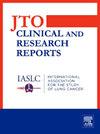Long-term Survival Analysis From PERLA, A Phase II Randomized Trial of Dostarlimab With Chemotherapy Versus Pembrolizumab With Chemotherapy in Metastatic Nonsquamous NSCLC
IF 3.5
Q2 ONCOLOGY
引用次数: 0
Abstract
Introduction
PERLA is a global, double-blind, phase II trial comparing anti–programmed cell death protein 1 antibodies, dostarlimab, and pembrolizumab in combination with chemotherapy (D+CT and P+CT, respectively) in patients with metastatic nonsquamous NSCLC without actionable genomic aberrations in the first-line setting.
Methods
Patients were randomized 1:1 to receive not more than 35 cycles of 500 mg dostarlimab or 200 mg pembrolizumab, with less than or equal to 35 cycles of 500 mg/m2 pemetrexed and less than or equal to 4 cycles of cisplatin (75 mg/m2) or carboplatin (area under the curve 5 mg/mL/min) every 3 weeks. The primary end point was the overall response rate by blinded independent central review. The secondary end points included progression-free survival (PFS) on the basis of investigator assessment, overall survival (OS), and safety. Here, we reported on the long-term OS, PFS, and safety analyses.
Results
At the end of the study (September 10, 2024), the median follow-up time (mo) for PFS was 30.4 for D+CT and 30.4 for P+CT. The median PFS (mo [95% confidence interval (CI)]) was 8.8 (6.9–11.0) for D+CT and 6.8 (4.9–7.1) for P+CT (hazard ratio 0.77 [95% CI: 0.58–1.03] at 79% maturity). The median follow-up time (mo) for OS was 35.5 for D+CT and 35.2 for P+CT. The median OS (mo [95% CI]) was 20.2 (14.5–27.3) and 15.9 (11.6–19.3), respectively (hazard ratio 0.75 [95% CI: 0.55–1.02] at 70% maturity). Safety profiles were similar between arms and consistent with previous analyses.
Conclusions
This long-term analysis reaffirms previous observations that D+CT exhibited similar efficacy to P+CT and exhibits strong clinical efficacy as a first-line treatment for patients with metastatic nonsquamous NSCLC.
Clinical trial registration
NCT04581824.
来自PERLA的长期生存分析,一项多斯塔利单抗联合化疗与派姆单抗联合化疗治疗转移性非鳞状NSCLC的II期随机试验
perla是一项全球性、双盲、II期试验,比较抗程序性细胞死亡蛋白1抗体、多斯塔利单抗和派姆单抗联合化疗(分别为D+CT和P+CT)在一线环境中无可操作基因组异常的转移性非鳞状NSCLC患者中的疗效。方法患者按1:1随机分组,接受不超过35个周期的500 mg的多司来单抗或200 mg的派姆单抗,培美曲塞≤35个周期的500 mg/m2,顺铂≤4个周期(75 mg/m2)或卡铂(曲线下面积5mg /mL/min)每3周。主要终点是盲法独立中心评价的总缓解率。次要终点包括基于研究者评估的无进展生存期(PFS)、总生存期(OS)和安全性。在这里,我们报告了长期的OS、PFS和安全性分析。结果研究结束时(2024年9月10日),PFS的中位随访时间(mo) D+CT为30.4,P+CT为30.4。D+CT的中位PFS (mo[95%可信区间(CI)]为8.8 (6.9-11.0),P+CT的中位PFS为6.8(4.9-7.1)(79%成熟度时风险比0.77 [95% CI: 0.58-1.03])。D+CT组OS的中位随访时间为35.5,P+CT组为35.2。中位OS (mo [95% CI])分别为20.2(14.5-27.3)和15.9(11.6-19.3)(70%成熟度时风险比为0.75 [95% CI: 0.55-1.02])。两组的安全性相似,与之前的分析一致。这项长期分析证实了先前的观察结果,即D+CT与P+CT具有相似的疗效,并且作为转移性非鳞状NSCLC患者的一线治疗具有很强的临床疗效。临床试验注册号:nct04581824。
本文章由计算机程序翻译,如有差异,请以英文原文为准。
求助全文
约1分钟内获得全文
求助全文
来源期刊

JTO Clinical and Research Reports
Medicine-Oncology
CiteScore
4.20
自引率
0.00%
发文量
145
审稿时长
19 weeks
 求助内容:
求助内容: 应助结果提醒方式:
应助结果提醒方式:


